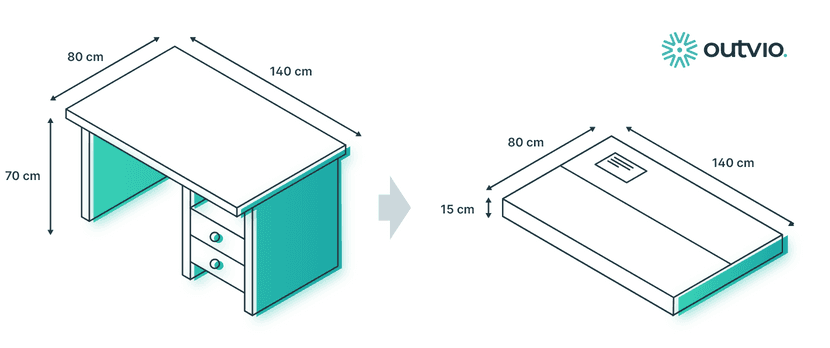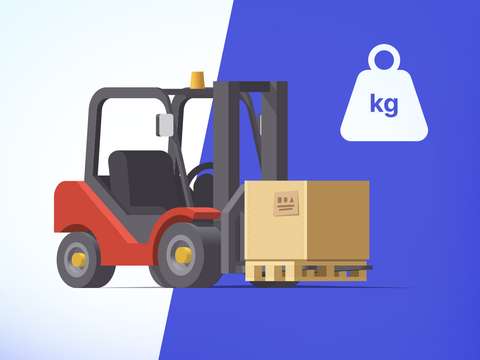Determining the shipping cost for your online sales is a delicate task. A percentage of your profit margin and customer retention depends on it. Opting for a high price could lead to losing buyers, while offering free shipping could result in losses. So, what do you do?
With this guide, we aim to answer some of the most common questions when determining shipping costs for online sellers: How much does it cost to ship? How is it calculated? What factors determine the cost? What is the average price? Let's take a look.
What are shipping costs: a dual perspective
The cost of shipping is the expense associated with transporting the goods sold from the warehouse to the final buyer. This cost is determined by several factors, such as the carrier's rate, packaging, labor, etc.
Many retailers choose to pass this cost on to their customers by applying an additional charge at the last stage of the online sale: the checkout. This means that the cost of shipping can be viewed from a dual perspective: the cost to the shop and the cost to the customer.

Why an online shop should determine shipping costs
Shipping is a critical factor in the online shopping experience. In fact, many consumers compare shipping prices before finalizing their order. Offering competitive rates or free shipping will differentiate you from the competition and increase your conversions.
According to a 2022 Inc report, 88% of consumers are inclined to shop at shops that offer free shipping.
Conversely, high shipping costs can lead to cart abandonment. A 2014 Tinuiti study revealed that 43% of consumers abandon their purchase if they perceive shipping prices to be too high.
Why should shops determine the shipping price when selling online?
- Profitability: Ensure a profit margin on each transaction.
- Differentiation: Stand out from the competition with attractive prices.
- Sales: Drive sales and conversions.
- Trust: Generate customer confidence with transparent shipping policies.
- Budgeting: Plan and manage costs efficiently.
In this article you will find further tips on how to reduce the cost of your shipments.
To determine the price, you must first calculate the cost
If you don't know the real cost of shipping, you could incur losses with every order, putting the profitability of your online shop at risk. Calculating the cost associated with shipping will allow you to evaluate different strategies and determine the best price for your financial or logistical circumstances.
So, the main reason for an online retailer to calculate the cost of shipping is to determine a competitive and strategically profitable price to his customer.
Recommend to read
Find out how to professionally manage your eCommerce shipments.
How to determine shipping costs when selling online in 2 steps
To determine the cost of shipping in our online sales, it is crucial to consider two key aspects: the average spend and the pricing strategy.
Let's see how to do it.
Step 1 - Calculate your average shipping cost
You must add up all costs (fixed and variable) and weigh them with the number of shipments made in a given period of time.
What factors determine the cost of shipping?
- Carrier rate: The price the carrier charges for its service. It usually depends on the weight, dimensions, and route of the shipment. The larger and heavier your package, the higher the rate
- Nature of the product: Fragile, dangerous, or perishable items require special treatment by logistics operators, which usually increases the price
- Surcharges: Charges added to the carrier's basic rate. The most common are shipping insurance, delivery management, schedule changes, customized tracking, fuel surcharges, shipping lagels, remote delivery zone, etc
- Cost of packaging: The price of packaging should also be added as a shipping cost. Boxes, envelopes, and cushioning materials can increase the cost more than you might think. Keep in mind that packaging is important to reduce shipping damage, so you should skimp on it
- Customs charges: If you are shipping internationally, you may have to pay certain customs duties and print additional documents
- Human capital: To find this out, you will need to compare the total number of shipments made with the cost of the staff involved in preparing the shipments
Tips for calculating your average shipping cost
- Track all your shipping costs: include all fixed and variable costs related to shipping, such as carrier fees, packaging materials, staff salaries, and insurance
- Determine the time period: choose a specific time period to analyze your shipping costs, such as a month or a quarter
- Divide the total costs by the number of shipments: to get the average shipping cost, divide the total sum of costs by the number of shipments made during the selected time period
Step 2 - Set a price strategy
The cost of shipping is closely linked to your business strategy.
For example, if you opt for free shipping, your customers will not pay for deliveries, and all shipping costs will fall on you.
You can also apply different rates, such as increasing the cost for international shipping through services like USPS and FedEx.
The most important shipping pricing strategies are:
Free shipping
Free shipping is the preferred choice of shoppers. It is estimated that offering free shipping can reduce abandonment by up to 18%. If you want to adopt this strategy, it is crucial to make sure that the cost of shipping does not exceed the profit made on each sale.
Fixed costs
The amount the customer pays for shipping is always the same. The effectiveness of this strategy depends on how competitive the selected price is. On the downside, do not encourage the shopper to add more items to the online basket, as the cost for shipping never changes.
By volumetric weight
Shipping costs vary according to volumetric weight. The customer will pay more for larger orders that require more transport resources on your part. This allows you to cover the added costs of heavier items while maintaining a competitive shipping price on smaller items.

Read more on volumetric weight and learn how you can calculate and reduce it to save on shipping costs.
By delivery time
Delivery charges are determined by the urgency of delivery requested by the buyer. Those who need an express carrier will pay more for deliveries, while longer deliveries will cost less.
By order value
The shipping costs fluctuate depending on the price of the order. This is most commonly used as the minimum threshold for a free order. What does this mean? An online shop can only offer free shipping to users who make purchases with a value of 50 euros or more. This is an incentive to add more items to the basket to reach the threshold. In fact, in 2022, 58% of US shoppers added more items to their basket in order to be able to ship for free.
How to calculate the price of your shipments: example
Let's imagine an online shop that sells fashion accessories at affordable prices. To establish the shipping price, they will first calculate their average cost, considering several factors:
- The shipping company charges a variable rate. Let's say that on average, this shop pays $5 per shipment
- The products are not fragile, so standard packaging is sufficient. There is no additional cost for this
- They do not offer additional shipping insurance.
- Packaging costs $0.20 per package
- Because they sell internationally, they incur an average customs charge of $2 per international shipment
- Staff dedicated to packing and shipping represents a cost of $500 per month. Assume that in a month, they prepare and ship 300 packages
Then, adding these costs together, the average shipping cost per package would be:
(5+0+0+0.20+2) + (500/300) = 7.20 + 1.67 ≈ $8.87
Once the shop has this average cost, they can set their shipping pricing strategy:
- Free shipping: They might choose to offer free shipping on all orders, absorbing the $8.87 cost per package
- Fixed shipping costs: They could set a single shipping price, for example, $6 per package. This could incentivize purchases by offering a known fixed price
- By weight or volume: If the package is heavier or larger, you could charge more. For example, $4 for light packages and $10 for heavy packages
- By delivery time: Offer express delivery options for an additional cost, e.g., $12 for 24-hour delivery and $6 for 3-day delivery
- By order value: Set a minimum purchase threshold for free shipping, such as $50. This would encourage customers to spend more to get the benefit of free shipping
How to figure out shipping costs? Conclusions
With so much competition in eCommerce, it is essential to calculate and choose the right shipping costs for both you and your customer. In this article, we have clarified terms and explained a number of formulas, but now it's time to get down to the nitty-gritty. To determine shipping costs when selling online, it is important to understand how to calculate them. You should consider factors such as weight, volume, and the destination of the package. This will help you estimate shipping costs and set competitive rates for your customers. In addition, you can adjust your shipping costs according to business needs and market conditions, such as during periods of high demand or special promotions.




